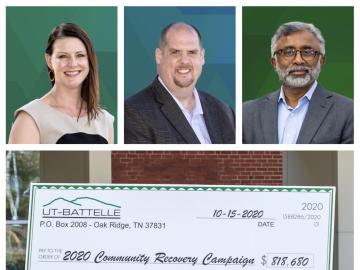
Filter News
Area of Research
- Advanced Manufacturing (10)
- Biological Systems (1)
- Biology and Environment (21)
- Building Technologies (1)
- Clean Energy (129)
- Climate and Environmental Systems (4)
- Computational Engineering (1)
- Computer Science (10)
- Energy Sciences (1)
- Fusion and Fission (5)
- Fusion Energy (11)
- Isotopes (4)
- Materials (105)
- Materials for Computing (5)
- National Security (17)
- Neutron Science (50)
- Nuclear Science and Technology (33)
- Nuclear Systems Modeling, Simulation and Validation (2)
- Quantum information Science (6)
- Supercomputing (69)
- Transportation Systems (1)
Date
News Topics
- 3-D Printing/Advanced Manufacturing (43)
- Advanced Reactors (21)
- Artificial Intelligence (20)
- Big Data (18)
- Bioenergy (21)
- Biology (5)
- Biomedical (26)
- Biotechnology (3)
- Buildings (1)
- Chemical Sciences (5)
- Clean Water (7)
- Climate Change (10)
- Composites (3)
- Computer Science (74)
- Coronavirus (23)
- Critical Materials (2)
- Cybersecurity (9)
- Decarbonization (1)
- Energy Storage (29)
- Environment (48)
- Exascale Computing (5)
- Frontier (3)
- Fusion (18)
- Grid (12)
- High-Performance Computing (3)
- Isotopes (9)
- Machine Learning (13)
- Materials (2)
- Materials Science (57)
- Mathematics (2)
- Mercury (2)
- Microscopy (13)
- Molten Salt (3)
- Nanotechnology (23)
- National Security (2)
- Neutron Science (48)
- Nuclear Energy (48)
- Physics (19)
- Polymers (9)
- Quantum Science (24)
- Security (5)
- Space Exploration (6)
- Summit (26)
- Sustainable Energy (32)
- Transformational Challenge Reactor (5)
- Transportation (27)
Media Contacts

Researchers at Oak Ridge National Laboratory were part of an international team that collected a treasure trove of data measuring precipitation, air particles, cloud patterns and the exchange of energy between the atmosphere and the sea ice.

Scientists from Oak Ridge National Laboratory used high-performance computing to create protein models that helped reveal how the outer membrane is tethered to the cell membrane in certain bacteria.

Oak Ridge National Laboratory researchers proved that the heat transport ability of lithium-ion battery cathodes is much lower than previously determined, a finding that could help explain barriers to increasing energy storage capacity and boosting performance.

Pauling’s Rules is the standard model used to describe atomic arrangements in ordered materials. Neutron scattering experiments at Oak Ridge National Laboratory confirmed this approach can also be used to describe highly disordered materials.

This spring, ORNL staff members quickly realized the devastating effect the coronavirus pandemic was having on their surrounding community. ORNL responded by revamping and expanding its community engagement program, which has resulted in boosting donations to more causes supported by the laboratory staff and by managing contractor UT-Battelle.

Planning for a digitized, sustainable smart power grid is a challenge to which Suman Debnath is using not only his own applied mathematics expertise, but also the wider communal knowledge made possible by his revival of a local chapter of the IEEE professional society.

When Sandra Davern looks to the future, she sees individualized isotopes sent into the body with a specific target: cancer cells.

There are more than 17 million veterans in the United States, and approximately half rely on the Department of Veterans Affairs for their healthcare.

To better understand how the novel coronavirus behaves and how it can be stopped, scientists have completed a three-dimensional map that reveals the location of every atom in an enzyme molecule critical to SARS-CoV-2 reproduction.
A collaboration between the ORNL and a Florida-based medical device manufacturer has led to the addition of 500 jobs in the Miami area to support the mass production of N95 respirator masks.


